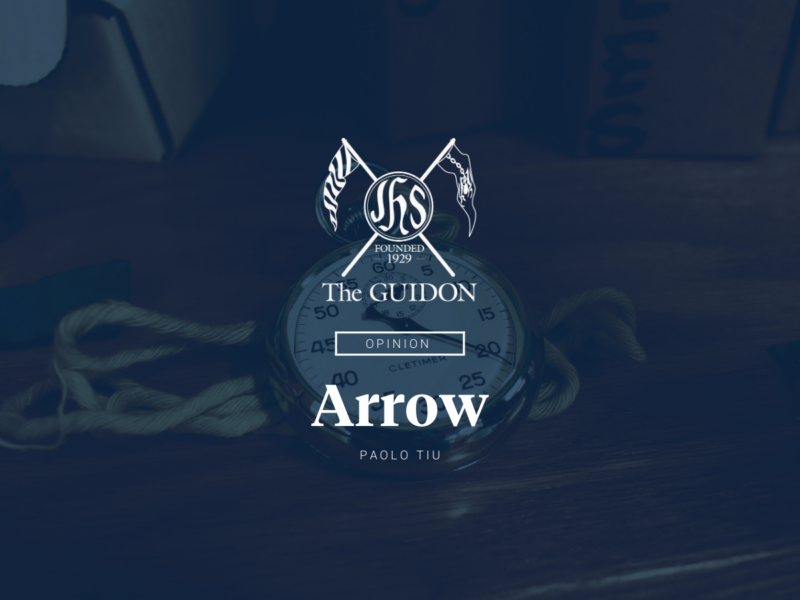View the accompanying infographic, Find your footing: A guide to accreditation, here.
It has been a whirlwind for Baybayin since the announcement of its accreditation last May 25, 2016. The organization, which aims to promote Filipino culture, is the newest accredited organization of the Council of Organizations of the Ateneo (COA). But that is not the only story Baybayin embodies. Baybayin also tells the story of what it really takes for an organization to become accredited.
Trusting the process
Organizations that aspire to be accredited must have an invitation from the Office of Student Affairs (OSA) to apply. Then, the organization must formally declare its intention to apply and submit documentary requirements in accordance with OSA guidelines.
Though the process seems straightforward, Director of the Office of Student Affairs Christopher F. Castillo explains the process goes beyond the submission of requirements and compliance with demands.
“The push for all our orgs is for them to have a clear purpose in the community and society-at-large. It has to go beyond a hobby or a past time. That’s why it tends to be very serious… emotional even. Hindi lang siya trip or tambay (It’s not just for fun or act as a hangout place),” he says.
While OSA acknowledges that documents such as the constitution and by-laws are indicators of a healthy organization, it is the embodiment of Ignatian values in these documents that they look for. OSA searches for and ensures these organizations are in-line with school principles and have a clear vision of their long-term goals through these documents.
Applicants are also required to have existed for at least two years before being able to apply for accreditation. Castillo explains that the two years serve as an “incubation” period to help organizations build a clear identity and purpose. This also serves a time for them to arrive at what makes them a distinct organization from others. Castillo mentions that at its core, there is discernment involved in the accreditation process.
“We would ask [the applicants], ‘What unique contribution can you make that no existing student group right now is also doing?‘ That’s why, at least in the area of accredited organizations, there is no overlap,” he says. This shows that the organization has a grasp of its identity, long-term goals, and willingness to achieve them.
Climbing the mountain
Castillo explains the process pushes the organizations to adapt to the processes and systems of OSA and COA. It serves as the training ground to simulate what the organizations will eventually face as accredited organizations. This can serve to pressure the applying organizations.
Baybayin President Marc Vanguardia admits that there was more pressure during their application, as it was clear to them that they wished to be accredited. He also talks of the pressure of being more careful of finances and adjusting to the processes of OSA, as well as the need to produce a 117-page activities report and a year-end status report to OSA to prove its eligibility to be formally granted accreditation.
However, Vanguardia talks of a benefit and reason for why these challenges were important. He admits to seeing the value of why OSA put Baybayin to the test. “Ito na yung kinailangan namin ipatunayan na kaya namin tumayo sa sarili naming paa… (This was the time to prove that we could stand on our own…)” he says.
But not all organizations are prepared to face the task at hand like Baybayin. Though Musikero has already established a distinct identity as an organization that teaches underprivileged children music, it has not yet sought accreditation.
Musikero President Mia Lim explains that because of the rigorous requirements of accreditation, they are currently prioritizing internal stability to help them prepare for the application in the long run. This is to adapt the organization’s structures and processes to be closer and more compliant with OSA’s requirements for eventual application.
However, some organizations feel that accreditation itself can be inconsistent with their organization’s culture and identity. This is one of the reasons Toushin, an unaccredited org focused on Japanese culture, decided against pushing through with its application.
Toushin president Isabel Pasco remarks one of the reasons their Executive Board was hesitant to follow through with their application was because some members felt that the obligations required from accredited organizations were incompatible with their culture and operational philosophy.
“Culturally, the way that Toushin works is very different. We don’t have a lot of that paperwork. One of main focuses this year is to make it a lot more informal but at the same time have our systems function quicker and more efficiently,” she says.
Changes like this were also on the mind of Baybayin’s Executive Board, Vanguardia admits. “Medyo natakot kami before paaccredit. Kasi baka maging masaydong formal ang sistema, na hindi na kasing init yung pakikitungo ng bawat isa (We were scared before we got accredited. We thought we might end up becoming too formal and the group wouldn’t be as passionate anymore),” he says.
These fears are not unwarranted. A study from 1986 by Dr. Philip M. Podsakoff, DBA, Larry J. Williams PhD, and William D. Todor, PhD, shows that organizations can fear the effect of additional rules and procedures on the identity of the organization. But the study shows that formalization of these organizations actually reduces these fears because it removes ambiguity in the structure and jobs of the organization and enhances commitment.
Vanguardia admits he believes the process of application allowed the organization to clearly define the roles of members. It also reaffirmed the organization’s mission vision and core competencies to promote Filipino culture. This is seen in the creation of an External Relations arm. While in the case of Musikero, it has begun preparing to formalize by clearly defining the roles of each member within the organization.
Weighing the benefits
Despite the demands that come with accreditation, many unaccredited organizations still aim to become members of COA. Baybayin worked hard to achieve accreditation, while Musikero has a long-term plan to do so.
Castillo says that the primary value of accreditation is the ability to use the Atenean name. “Any barkada, if you think about it, can talk to other external groups,” he says.
Accreditation enables the organization to be associated “legally and officially” with the school. Effectively, the organization becomes an organization of the Ateneo, rather than an organization comprised of Atenean students.
Lim cites this as one of the biggest incentives for Musikero to apply for accreditation. She explains that accreditation gives an org legitimacy, which can translate to higher member involvement and commitment. Lim says that she’s seen members stay inactive because they feel the org isn’t “real” due to its lack of accreditation. She maintains that legitimacy is crucial for member recruitment. “We want to be accredited because we want to join Recweek. The normal Recweek. Because that’s where you’re recognized by the whole LS campus,” she says. She remarks that unaccredited status can discourage freshmen from applying because it implies that an org is “not really Atenean.”
The legitimacy granted by accreditation goes outside the Loyola Schools community, which can help an organization’s relationships with companies and institutions.
Accredited organizations also gain access to financial and human resources unavailable to unaccredited organizations. “We do give allocations and access to a variety of subsidies for accredited organizations. But also, if you’re an organization and you have the Ateneo name then you can get into marketing deals, sponsorship deals, and so and so forth,” Castillo says.
Another benefit is access to training and formation programs given by OSA. This includes lectures, retreats, and seminars which are offered through the various formation offices of the school.
However, this is not to say that unaccredited organizations are ignored. Castillo explains that during the application process, orgs undergo a program where they are treated as if they were given accreditation already. This is to measure whether the orgs can take the “rigor” of accredited organizations.
Additionally, Castillo notes that unaccredited organizations are integrated within the student leader community to help with the process. “It’s not like elitist ‘Hindi hindi, bawal ka dito’(‘No, no, you’re not allowed here’), and so the unaccredited org in a sense gets a feel of where they could be, and COA, vice versa, gets a feel: ‘What is this org about? What is it like?’” he says.
Despite these, Musikero feels not having access to some of these benefits makes it difficult for them to plan and execute their projects. Lim brings up the struggle of reserving a venue—something accredited orgs can do a month in advance, compared to their two weeks’ notice. “Paano yung fundraisers namin? Paano yung projects na iyon?(What about our fundraisers? What about our projects?),” she says.
Not for everyone
The journey to accreditation is a choice not all organizations pursue. It goes beyond the question of requirements or benefits, and tests an organization’s core philosophy and purpose.
But Castillo emphasizes whether accredited or not, student organizations contribute to the “vibrance of student life.”
“At the end of the day, [they are] Ateneans and nasa DNA nila yun eh. Hindi matatanggal. Wala lang yung apilyedo pa na ‘Ateneo’ kasi hindi pa sila accredited, but they are Ateneans and so they are worthy [in] whatever they do, wherever they do it (At the end of the day, being an Atenean is in their DNA and you can’t remove that. Sure, you don’t have the name officially, but they are still Ateneans),” he says.







